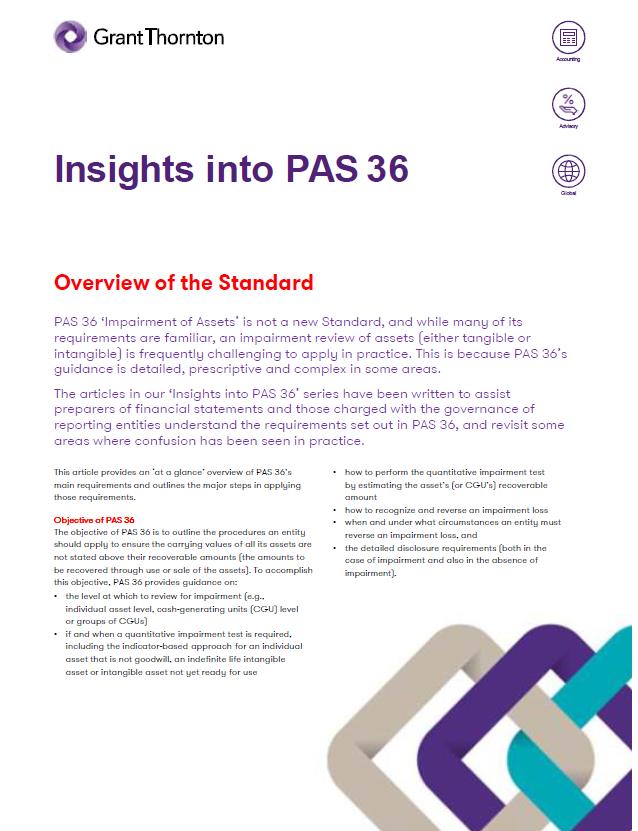This Accounting Alert is issued to provide an overview of Philippine Accounting Standards (PAS) 36, Impairment of Assets, to assist preparers of financial statements and those charged with governance of reporting entities in understanding the requirements of PAS 36, and to revisit some areas where confusion has been seen in practice.
Overview
PAS 36 ‘Impairment of Assets’ is not a new standard, and while many of its requirements are familiar, an impairment review of assets (either tangible or intangible) is frequently challenging to apply in practice. This is because PAS 36’s guidance is detailed, prescriptive and complex in some areas.
Scope
PAS 36 applies to all assets other than those for which the measurement requirements of other Philippine Financial Reporting Standards (PFRS) are such that a PAS 36-based impairment review is irrelevant or unnecessary.
Assets outside PAS 36’s scope include:
- Inventories;
- Financial assets in the scope of PFRS 9 ‘Financial Instruments’;
- Contract assets and assets arising from costs to obtain or fulfill a contract recognized in accordance with PFRS 15 ‘Revenue from Contracts with Customers’;
- Deferred tax assets;
- Assets arising from employee benefits;
- Assets classified as held for sale;
- Investment property measured using the fair value model;
- Biological assets related to agricultural activity within the scope of PAS 41‘Agriculture’ measured at fair value less costs to sell; and,
- Contracts that are assets and any assets for insurance acquisition cash flows in the scope of PFRS 17 ‘Insurance Contracts’.
PAS 36 apply to:
- financial assets classified as subsidiaries, associates and joint ventures (unless measured at fair value);
- property, plant and equipment and intangible assets carried at a revalued amount in accordance with other PFRS; and,
- Right-of-use assets measured in accordance with PFRS 16 ‘Leases’.
Identifying an Asset that may be Impaired
PAS 36 prescribes the timing requirements for performing quantitative impairment testing as well as potential ‘indicators’ of impairment that may trigger impairment testing for some assets or groups of assets. Specifically, PAS 36 requires that:
- goodwill, indefinite life intangibles and intangible assets not yet available for use are tested for impairment at least annually, in addition to when there is any indication of impairment; and,
- all other assets are tested for impairment when there is any indication that the asset may be impaired.
Level of Review
PAS 36 prescribes the level of review for impairment:
- where possible, an entity will estimate the recoverable amount of an individual asset, or
- when this is not possible, an entity will determine the recoverable amount of the Cash Generation Unit (CGU) to which an asset belongs.
For the purposes of impairment testing, PAS 36 prescribes how to allocate goodwill and corporate assets to CGUs.
Recognizing an Impairment Loss
PAS 36 requires an entity to recognize an impairment loss when the carrying amount of an asset or CGU exceeds its recoverable amount, and provides guidance on how to recognize that loss, by outlining:
- the requirements for recognizing and measuring impairment losses for an individual asset;
- the requirements for allocating losses when such losses are calculated for a CGU; and,
- additional considerations for allocating an impairment loss when there is a non-controlling interest.
Reversing an Impairment Loss
PAS 36 sets out the requirements for reversing an impairment loss recognized for an asset or CGU in prior periods by:
- prescribing timing for assessment
- providing indicators that an impairment loss recognized in prior periods for an asset (other than goodwill) or CGU may no longer exist or may have decreased, and
- prescribing the accounting for reversing a prior impairment loss, including limitations on the amount that can be reversed.
Disclosure
PAS 36 sets out the disclosure requirements related to impairment. Some disclosures apply in the event an entity records an impairment loss while others are required irrespective of any impairment loss.
The Accounting Alert also provides detailed discussion of the standard's principle, key definitions, and step-by-step impairment approach.
See attached Accounting Alert for further details.

